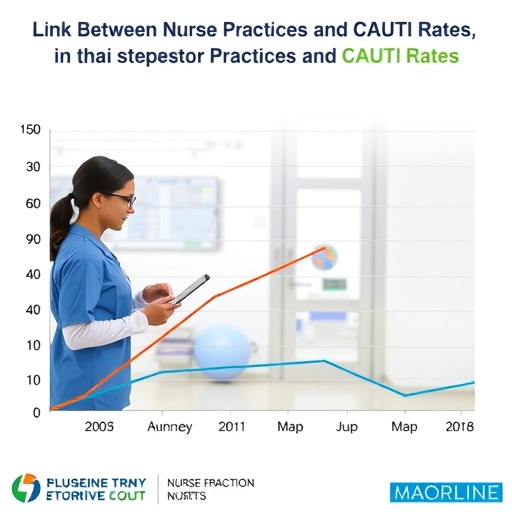In the dynamic landscape of healthcare, the relentless pursuit of improving patient outcomes takes center stage. One area of significant concern within intensive care units (ICUs) is the prevention of catheter-associated urinary tract infections (CAUTIs). Recent research conducted by a team of experts led by Karami et al. sheds light on the critical relationship between nurses’ knowledge and their practical interventions to prevent CAUTIs, a complication that poses serious risks to ICU patients.
This illuminating study published in BMC Nursing explores how the depth of nursing education directly affects the incidence of urinary tract infections in a critical care environment. As the prevalence of indwelling catheters continues to rise, so too does the potential for infection, making it imperative that nursing staff are well-versed in prevention strategies. This research aims to bridge the gap between theoretical knowledge and practical skills in a high-stakes environment.
The research team employed a methodical approach, beginning with a detailed survey distributed to ICU nurses to assess their understanding of CAUTI prevention protocols. The results revealed a staggering correlation: nurses who possessed a thorough knowledge base were significantly more likely to implement effective practices that limited the incidence of UTIs. This realization underscores the urgency of prioritizing education in nursing curricula, particularly in specialized fields where patient vulnerability is high.
Moreover, the implications of this study extend beyond mere statistical correlations. The findings call for a reassessment of current training methodologies used in preparing nursing professionals. As healthcare continues to evolve, fostering an educational framework that bridges theory with practice will be vital in enhancing patient care. The challenge lies not just in imparting knowledge but in ensuring that nurses possess the confidence and skills to implement this knowledge effectively in real-world scenarios.
In the context of high-pressure environments such as ICUs, decision-making is paramount. Nurses often find themselves at the frontline of patient care, and their ability to make informed choices can dictate patient outcomes. This research illustrates how a well-informed nursing workforce can lead to reduced CAUTI rates, ultimately translating into better health outcomes for the patients entrusted to their care.
In addition, the study also highlights the importance of continuous professional development and training for nursing staff. Regular updates on best practices in infection control are essential in maintaining high standards of care. The healthcare field is ever-changing, and as new research emerges, it is critical that nursing professionals stay current with the latest protocols and guidelines to avoid outdated practices that could endanger patient health.
Another noteworthy aspect of the study is its focus on interdisciplinary collaboration. The authors suggest that effective communication between nursing staff, physicians, and other healthcare providers is fundamental in preventing CAUTIs. By working together, healthcare teams can create a cohesive approach to patient care that diminishes the risk of complications, fostering a safer environment for the most vulnerable patients.
The financial implications of CAUTIs are substantial, affecting not only patient health but also healthcare systems as a whole. The treatment of UTIs can lead to prolonged hospital stays, increased operating costs, and a burden on resources. Reducing infection rates through better nursing practices aligns with the goals of healthcare management to optimize outcomes while minimizing expenditures. This study serves as a clarion call for healthcare administrators to invest in nursing education as a means of cost-effective care delivery.
Moreover, the research presents an opportunity for healthcare policymakers to shape future regulations and standards in nursing practice. As evidence mounts regarding the correlation between nursing knowledge and patient outcomes, it is imperative that health policy advocates consider these factors when drafting guidelines that govern nursing practice. This could lead to more stringent requirements for nursing education on infection control, particularly in high-risk areas such as critical care.
Building a culture of safety within healthcare settings is not merely an aspiration; it is a necessity. This study reinforces the concept that education plays a crucial role in this endeavor. By equipping nurses with the knowledge they need to combat CAUTIs, we can cultivate an environment that prioritizes patient safety above all else. This shift requires a collective commitment from educators, healthcare leaders, and policymakers to ensure that nursing practice not only meets but exceeds current safety standards.
In conclusion, the study conducted by Karami et al. signifies a pivotal moment in understanding the intricate relationship between nursing knowledge and patient care in the context of CAUTIs. As the healthcare industry faces ongoing challenges related to infection control, the insights garnered from this research can lay the groundwork for enhancements in nursing education and practice. By taking proactive steps to integrate this knowledge into everyday workflows, we can work towards significantly reducing the incidence of urinary tract infections and improving the overall quality of care.
The endeavor does not end here; it is essential for ongoing dialogue within the healthcare community to reflect upon these findings and to continuously seek innovative strategies to empower nurses. By fostering a culture of learning and adaptation, the healthcare industry can ensure that it rises to meet the challenges that lie ahead. With the ground shifting beneath our feet, the only path forward is one that embraces knowledge, practice, and collaboration in equal measure.
Subject of Research: Correlation between nurses’ knowledge and practices in prevention of catheter-associated urinary tract infection (CAUTI) with UTI incidence in ICU.
Article Title: Correlation between nurses’ knowledge and practices in prevention of catheter-associated urinary tract infection (CAUTI) with UTI incidence in ICU.
Article References:
Karami, A., Majedi, M.A., Kamyari, N. et al. Correlation between nurses’ knowledge and practices in prevention of catheter-associated urinary tract infection (CAUTI) with UTI incidence in ICU.
BMC Nurs 24, 1252 (2025). https://doi.org/10.1186/s12912-025-03910-3
Image Credits: AI Generated
DOI: 10.1186/s12912-025-03910-3
Keywords: CAUTI, ICU, nursing education, infection control, patient outcomes, healthcare policy, interdisciplinary collaboration.
Tags: bridging theoretical knowledge and practical applicationcatheter-associated urinary tract infectionsCAUTI prevention strategiescritical care nursing researcheffective nursing interventionshealthcare quality improvementimportance of practical nursing skillsinfection control in hospitalsintensive care unit practicesnurse education and trainingnursing knowledge and patient outcomesrelationship between nurse practices and infections





